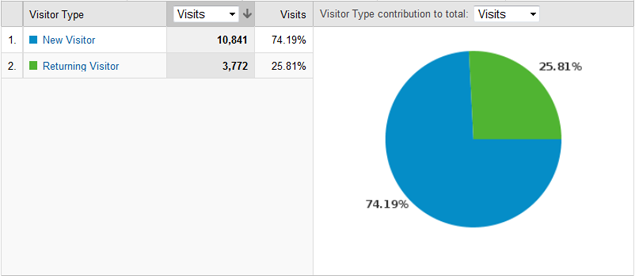Selling Advertising Space Part 2: Do You Get Enough Traffic And How Much Should You Charge?

Welcome to part 2 of this article series! In this post, I will continue on with questions 4-6:
- Do I get enough traffic to entice advertisers?
- Do I get enough page views to make it worth my advertisers’ expense?
- How much should I charge?
Do I get Enough Traffic to Entice Advertisers?
As I mentioned in part one, I didn’t see the point in selling ad space until my blog generated a decent amount of traffic. After all, who’s going to purchase ad space on a website that gets little to no traffic? I had to allow myself some time to generate a steady stream of visitors.
So, what’s a decent amount of traffic? Well, I received over 5,000 unique visitors (over 10,000 page views) in August 09. This isn’t going to break any records, but it is much more than I anticipated this early in my blog’s existence.
So, is 5,000 enough to begin selling ad space? What about 10,000?
In my opinion, the answer to this question can be found by looking at the following factors:
How Much You Want to Charge for an Ad Space
If you want to charge $1000.00/month for an ad position on a website that only receives 1,000 visitors/month, you’re going to make potential advertisers laugh in amusement. That’s just not worth their time or money.
Truth is you can begin selling ad space on day one of launching your website as long as your price reflects the benefits your advertisers will receive. You must remain fair with your pricing and avoid over-simplified comparisons. You know – comparing your prices to that of the top bloggers’. They get a TON of traffic and their prices accurately reflect the value of their ad positions.
Try looking at your blog from the perspective of a potential advertiser. Based on what you know of your traffic, how much would you be willing to pay for an ad on your sidebar?
For more specifics, I will discuss the CPM formula later in this post.
How Many NEW Visitors You Receive Each Month
This is something I never really considered to be that important of a figure until I decided to begin selling ad space. Advertisers want their banners to be exposed to as many people as possible. If you already have an audience/following, you probably also have a small number of repeat visitors (visitors that visit your website once a week or even once a day). Advertisers may not be as interested in your repeat visitors (since they’ve seen all of the ads already) as they may be in your NEW visitors – visitors who haven’t seen your ads yet.
Take a look at your traffic stats and observe how many new visitors you receive each month. In my first three months, about 75% of my traffic was made up of new visitors. This is a great figure to throw out at potential advertisers! It indicates you are constantly obtaining new sources of traffic.

Don’t Forget to Count Your Followers!
It’s not all about how much traffic you’ve already received, but how much traffic you have the potential for driving back to your website. So, make sure to take into account your Twitter Followers, Facebook Fans, RSS Subscribers, Newsletter Subscribers, etc. These social networks are potentially comprised of your next month’s visitors and advertisers will be keen to know about them.
Plus, each of your followers has the potential to tweet/post about your blog and bring new streams of traffic (and fresh visitors) to your site!
The Quality of Your Content
Does your content attract visitors? Does it entice visitors to leave comments? Is it creating an active audience on your website? If so, then you’re creating trust and relationships with your readers. And with those relationships comes potential click-throughs for advertisers as your visitors will be more inclined to click on a banner you’ve approved for display on your site.
Do I get enough page views to make it worth my advertisers’ expense?
Keep in mind that most advertisers pay for Page Views – not unique visitors. So, you may only get 1,000 unique visitors to your website every month, but if each of those visitors click through to 10 pages on your site, you’re getting 10,000 page views a month! That is a pretty good figure and one that will certainly entice some advertisers.
Page views are extremely important to observe. They tell you how well your call to action is working or how beneficial your content is to your visitors. If your average page view is less than 2 per visitor, it means most of your visitors leave after only seeing one page of your website – that’s NOT good!
Ideally, every one of our visitors would visit every page on our site, but that’s extremely far-fetched. But, your visitors should at least view two pages per visit. That means the first page they landed on enticed them enough to stick around and visit another page.
What do lots of page views mean to advertisers? A couple things:
- Your website does a great job at keeping your visitors’ attention.
- Your advertisers have more chances for impressions and possible click-throughs.
If your average page view figure is low, begin analyzing your site to determine what the issue(s) might be. Is your navigation easy to find? Is your content well organized? Is your content relevant to your readers?
How much should I charge?
This is probably the first and biggest question you asked yourself about selling ad space on your website – it was for me.
In order to determine the price of your banner positions, you must first understand what advertisers are actually paying for.
Cost Per Impressions
As I mentioned above, advertisers normally pay for Page Views – not unique visitors. And they usually pay per 1000 page views (or impressions).
- Page Views = Impressions
- CPM = Cost Per 1,000 Impressions
So, you have to determine how much you are willing to charge advertisers for every 1000 impressions they receive on your website. Here’s when low page views hurt your perspective ad sales. It must be worth the advertiser’s expense. So, let’s break this down.
Example #1:
125px Banner → Displayed On Every Page of Website → 10,000 Page Views/mo = $15/mo.
The way an advertiser will break this down is by taking the cost ($15.00) and dividing it by the number of page views (10,000). They will then multiply the result by 1,000 to get their Cost Per 1000 Impressions (CPM). So, let’s see what their cost will be for our example.
1. Divide Your Banner Cost By Your Page Views:
$15 / 10,000 Page Views = .0015
2. Calculate the CPM (Cost Per 1,000 Impressions):
.0015 X 1,000 = $1.50
In our example, you would charge an advertiser $1.50 PER 1,000 impressions (or page views) if you chose to sell your 125px ad for $15/month.
So, why not just use the .0015 and say that you charge .0015 cents per impression? Well, this is most likely due to the fact that advertisers want to work with as many page views as possible and anything less than 1,000 wouldn’t be worth their time. Plus, calculations based on fractions of cents aren’t really popular :).
$15.00 is what I decided to charge for my 125px ad position. Why don’t we take a look at one more example so you can get used to this calculation…
I’m charging $45.00/month for a spot on my 728px banner position. This spot rotates with 1 other ad, so we will have to divide page views by 2 in order to calculate the CPM correctly.
Example #2:
728px Banner → In Rotation with 1 Other Ad → 5,000 Page Views/mo (10,000/2) = $45/mo.
First, Divide Your Banner Cost By Your Page Views:
$45 / 5,000 Page Views = .009
Second, Calculate the CPM (Cost Per 1,000 Impressions):
.009 X 1,000 = $9.00
So, I’m charging advertisers $9.00 PER 1,000 impressions (or page views) for my 728px ad.
Now we know what we’re charging for. So how much should we charge?
Determine Your Price
Probably the easiest way to determine your price for ads is to use other websites in your niche as examples. In my case, I used Entrepreneurs-Journey.com and JohnChow.com as comparisons.
ENTREPRENEUR’S JOURNEY
Yaro receives 138,000 Page Views per month on his blog. He charges $200/month for a 125px banner position. This position is displayed on every page of his blog. So, let’s take a look at the CPM he’s charging.
($200 / 138,000 Page Views) X 1,000 = $1.45
Yaro charges $1.45 per 1,000 impressions for his 125px ad position.
JOHN CHOW
John receives 300,000 Page Views per month on his blog. He charges $500/month for a 125px banner position. This position is displayed on every page of his blog. So, let’s take a look at the CPM he’s charging:
($500 / 300,000 Page Views) X 1,000 = $1.67
John charges $1.67 per 1,000 impressions for his 125px ad position.
MY RATE
I chose to charge $1.50 per 1,000 impressions for my 125px ad position. Yaro receives 1,380% more traffic than me. If I divide his price ($200) by 1380%, I get approximately $15, which is what I decided to charge. It’s high enough for me to make a little bit of money, but less than the average CPM of the two big blogs I used as a comparison.
YOUR RATE
Go ahead and do the same thing I did. Visit some blogs/websites related to your niche and see if they offer ad space. If so, check out their prices and page views and calculate their CPMs. Use these figures to determine your rate.
Next: Part 3
In part 3, I will cover the next two questions:
- What type of ad manager should I use / How do I sell the space?
- Should I offer text links, banner ads, paid reviews, etc?
How Did You Determine Your Ad Prices? Does the CPM Formula Confuse You? What Tips Can You Give the Rest of Us On Pricing Ads?
You’re Viewing a Post Series!
This post is only one part of our discussion. Check out the other parts below:
- Selling Advertising Space Part 5: How to Convince Advertisers to Buy Your Space
- Selling Advertising Space Part 4: Choosing Payment Options, Deciding On Subscription Lengths and Offering Refunds
- Selling Advertising Space Part 3: How Do I Manage and Sell Ad Space and What Type Should I Offer?
- Selling Advertising Space Part 2: Do You Get Enough Traffic And How Much Should You Charge?
- Selling Advertising Space Part 1: Is Your Website Ready to Sell Ad Sponsorships?
Topic Tags:
ad manager, banner price, blogging, make money online, selling ad space, yaro starak









 I’m Keller Hawthorne, Founder of FresheVenture.com. Whether you’re new to the world of Internet Marketing or already have your own Internet Business, I’m here to help you make a living online!
I’m Keller Hawthorne, Founder of FresheVenture.com. Whether you’re new to the world of Internet Marketing or already have your own Internet Business, I’m here to help you make a living online! 
 Subscribe to My RSS Feed!
Subscribe to My RSS Feed!